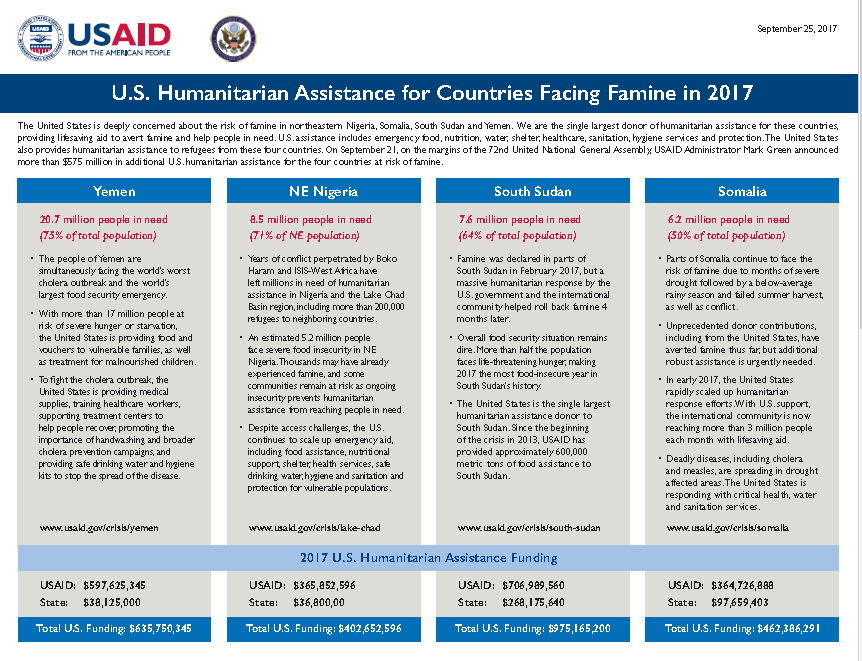Speeches Shim
The United States is deeply concerned about the risk of famine in northeastern Nigeria, Somalia, South Sudan and Yemen. We are the single largest donor of humanitarian assistance for these countries, providing lifesaving aid to avert famine and help people in need. U.S. assistance includes emergency food, nutrition, water, shelter, healthcare, sanitation, hygiene services and protection. The United States also provides humanitarian assistance to refugees from these four countries. On September 21, on the margins of the 72nd United National General Assembly, USAID Administrator Mark Green announced more than $575 million in additional U.S. humanitarian assistance for the four countries at risk of famine.
Yemen
20.7 million people in need (75% of total population)
The people of Yemen are simultaneously facing the world’s worst cholera outbreak and the world’s largest food security emergency. • With more than 17 million people at risk of severe hunger or starvation, the United States is providing food and vouchers to vulnerable families, as well as treatment for malnourished children. • To fight the cholera outbreak, the United States is providing medical supplies, training healthcare workers, supporting treatment centers to help people recover, promoting the importance of handwashing and broader cholera prevention campaigns, and providing safe drinking water and hygiene kits to stop the spread of the disease.
NE Nigeria
8.5 million people in need (71% of NE population)
Years of conflict perpetrated by Boko Haram and ISIS-West Africa have left millions in need of humanitarian assistance in Nigeria and the Lake Chad Basin region, including more than 200,000 refugees to neighboring countries.
An estimated 5.2 million people face severe food insecurity in NE Nigeria. Thousands may have already experienced famine, and some communities remain at risk as ongoing insecurity prevents humanitarian assistance from reaching people in need.
Despite access challenges, the U.S. continues to scale up emergency aid, including food assistance, nutritional support, shelter, health services, safe drinking water, hygiene and sanitation and protection for vulnerable populations.
South Sudan
7.6 million people in need (64% of total population)
Famine was declared in parts of South Sudan in February 2017, but a massive humanitarian response by the U.S. government and the international community helped roll back famine 4 months later.
Overall food security situation remains dire. More than half the population faces life-threatening hunger, making 2017 the most food-insecure year in South Sudan’s history.
The United States is the single largest humanitarian assistance donor to South Sudan. Since the beginning of the crisis in 2013, USAID has provided approximately 600,000 metric tons of food assistance to South Sudan.
Somalia
6.2 million people in need (50% of total population)
Parts of Somalia continue to face the risk of famine due to months of severe drought followed by a below-average rainy season and failed summer harvest, as well as conflict.
Unprecedented donor contributions, including from the United States, have averted famine thus far, but additional robust assistance is urgently needed.
In early 2017, the United States rapidly scaled up humanitarian response efforts. With U.S. support, the international community is now reaching more than 3 million people each month with lifesaving aid.
Deadly diseases, including cholera and measles, are spreading in drought affected areas. The United States is responding with critical health, water and sanitation services.


Comment
Make a general inquiry or suggest an improvement.